Key takeaways.
-
What are the differences between different magic mushroom strains?
Different magic mushroom strains have varying levels of psilocybin and psilocin, they look different, have different environments, and different patterns of spore production. The effects produced by different strains also vary.
-
What are some popular magic mushroom strains?
Some popular varieties include Golden Teacher, Amanita muscaria, African Transeki, and Amazonian cubensis.
-
How many magic mushroom strains are there?
There are literally millions of magic mushroom strains. Believe it or not, we still don't know many of the species that exist. That's why you should never go mushroom hunting without a mycologist!
Just like with cannabis, there are many different species and strains of psychedelic mushrooms. With cannabis, there are really only two species with many strains. But with psychedelic mushrooms, more popularly known as magic mushrooms, many species contain naturally occurring psychoactive compounds; and within those species, there are many different magic mushrooms strains. Over 200 species, to be exact, each with multiple strains that have slight variations in appearance, potency, growth conditions, and effects.
For example, you might have heard of Psilocybe cubensis or Amanita muscaria; these are two different species of magic mushrooms. But when we’re talking about Golden Teachers or Amazonian Cubensis, we’re talking about magic mushroom strains of Psilocybe cubensis.
These psychedelic mushrooms have a rich history of being utilized in spiritual and religious ceremonies and for mind-altering experiences.
In this guide, we explore the difference between magic mushroom strains and species before diving into the most popular psychedelic mushroom types, from psilocybin mushroom strains like Blue Meanies, Golden Teachers, Liberty Caps, Penis Envy, and African Transkei, to the infamous magic mushroom strain that is rumored to have inspired Christmas—the Fly Agaric.
Understanding a little bit of taxonomy helps to avoid confusion when talking about specific strains and species, and it will also make you feel like a little bit of a mycologist!
With the exception of the Fly Agaric, each of the psilocybin mushroom strains on this list varies in the amount of psilocybin and psilocin it contains—and the experience it provides. Psilocybin levels can range from 0.1% to almost 2%, with an average of around 0.8%.
What are psychedelic mushrooms?
Magic mushroom strains are the fruiting body of fungi that contain psychoactive compounds and fall into the category of classic psychedelics. These compounds can cause profound changes in perception, thought, and mood, and have been shown to be highly beneficial for helping resolve complex mental health issues and bring human beings into higher states of consciousness.
Outside of the clinical setting, psychedelic fungi like Psilocybin mushrooms have been used by humans for centuries for recreational and spiritual purposes.
There are many different strains of mushrooms, each with its unique properties and effects, and most of which are grown indoors in highly controlled settings. However, there are also many species that flourish in the wild, each with their own psychoactive compounds.
The most well-known is psilocybin, which is closely related to the chemical compound serotonin. But psilocybin mushroom strains also contain other compounds, like psilocin, a chemical indole hallucinogen affecting the neurotransmitter serotonin in the brain, and other analogs of psilocybin such as baeocystin, norbaeocystin, bufotenin, and others.
Psilocin is much more bioactive than psilocybin; in fact, psilocybin actually transforms into psilocin once ingested, which is what gives psilocybin mushrooms their psychedelic properties. The effects of psilocin are similar to those produced by mescaline and LSD and can last for several hours.
In the Amanita muscaria's case, the psychoactive alkaloids interact with different neurotransmitter receptors and are a little more diverse. These alkaloids and their neurotransmitter receptors include:
- Ibotenic acid, which resembles the major stimulatory brain neurotransmitter glutamic acid (glutamate)
- Muscimol, which resembles the major inhibitory neurotransmitter gamma amino butyric acid (GABA)
- Muscarine, which resembles the acetylcholine, which can be excitatory and inhibitory.
Because mushrooms have these different types of alkaloids, the journey can be perceptually different and the potential health outcomes could vary across strains. This is similar to the “entourage effect” in cannabis where cannabinoids like THC and CBD work together in the body, it’s thought that the alkaloids in different magic mushroom strains act synergistically to produce unique effects.
More research is needed to understand if different magic mushroom strains could be advantageous for specific health outcomes.
In recent years, magic mushrooms, particularly psilocybin mushrooms, have been gaining increased attention for their potential therapeutic benefits and potential to treat mental health disorders like depression, anxiety, and PTSD.
Whether you’re looking to understand the effects of psilocybin mushrooms or want to learn more about different varieties, enjoy this review of several common varieties of psychedelic mushrooms.
SUMMARY
There are 14,000 different species of mushrooms, and more than 180 different kinds of mushrooms containing psilocybin, the primary psychoactive ingredient in what’s often referred to as “shrooms.”
Magic mushroom strains vs species: Understanding the hierarchies.

In the scientific categorization of virtually any living organism on earth, there’s a taxonomical hierarchy. It goes in the order of Kingdom → Phylum → Subphylum → Class → Order → Family → Genus → Species.
For the purpose of magic mushroom strains, we’re mostly interested in the genus and species. For example, let's look at Psilocybe cubensis and Psilocybe subaeruginosa. In these two species, the genus is Psilocybe. However, it’s their species that differ: one being cubensis and the other being subaeruginosa.
A magic mushroom strain is like a phenotype. It means that the organism is in the same genus and species, but because it grows in different conditions, it has small variations in chemical composition. Strains can also be produced by crossing with other strains, which can then be stabilized and grown in any optimal and consistent conditions (this is exactly what we do with cannabis strains!).
To understand the concepts of magic mushroom strains, let’s look at the example we gave in this guide's introduction.
Amazonian Cubensis and Golden Teachers are both from the Psilocybe cubensis species of mushrooms. However, they vary in chemical composition and give slightly different effects, so we refer to them as different strains of the same species of magic mushrooms.
Is there a difference between magic mushroom strains?
Yes — absolutely.
Much like cannabis, psychedelic mushrooms have an entourage effect, which means that the different ratios of the compounds found in each mushroom produce different effects.
Some might be more visual while others might be more physical. Some are stronger than others, making them less appropriate for beginners, and so on. For more detailed information on dosing, check out our Magic Mushroom Dosage Guide.
Read: The Strongest Mushroom Strains Ranked By Potency
Let’s check out some of the different magic mushroom strains, their species, and what they’re all about!
Disclaimer:
This is just an informational article about the different varieties of magic mushrooms. This is not a guide for picking mushrooms. Only mycologists should go out and pick mushrooms. We don’t recommend going out to identify mushrooms beyond pure leisure, as it’s very easy to accidentally pick a poisonous mushroom. Please do not use this as a guide for picking mushrooms.
Psychedelic Mushroom Types: Top Species to Know
1. Golden Teacher Mushrooms — Psilocybe cubensis.
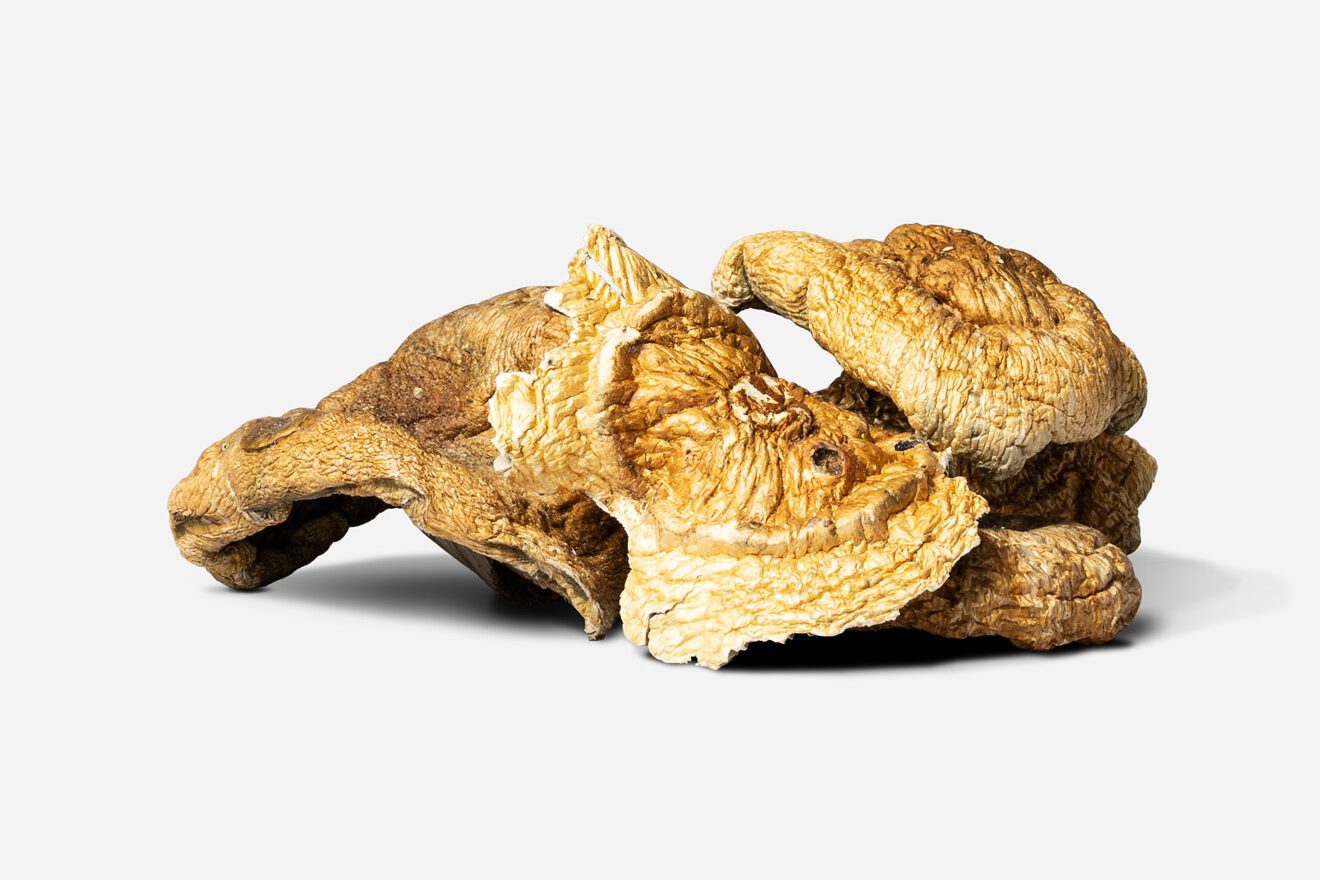
One of the most popular magic mushroom strains in our shop, Golden Teachers falls under the Psilocybe cubensis species. They’re given their name because they are “enlightening” the way a gentle teacher might be.
The stems of Golden Teachers are long, curving, and quite thick, often growing in "families." They're marked by their golden caps with little white spots. But as they mature, the intensity of the golden top starts to fade, so it’s said that they’re at their biggest when the gills open up and start to drop spores.
They are a popular choice for growers because they are easy to cultivate at home.

Golden Teachers have a moderate strength level, and are good for beginners because they’re gentle on the psychedelia. There’s still a strong psychedelic effect, but it seems they’re much better tolerated by beginners than other, stronger species of Psilocybe.
With Golden Teacher and other medium-strength mushrooms, start at 0.5 to 1 gram. There usually won’t be any hallucinations at this dosage, but you’ll feel an enhancement in your mood and mental state.
Read: The Ultimate Magic Mushroom Dosage Guide
If you’re looking for a stronger trip where you experience visual hallucinations, a reasonable dosage is 1-2 grams. Two grams allow you to experience the effects without feeling overpowered or out of control. A higher dosage would start at three or more grams, and consuming more than five grams would be considered a macrodose and would lead to a full transcendent experience.
You can purchase high-quality organic Golden Teacher mushrooms our own online shop. If you prefer taking your mushrooms through precisely dosed capsules, we offer both microdose and macrodose formulas for every goal and need. For example, Brain Stack is our master nootropic microdose formula for optimal cognition + brain health, and Balanced High (a.k.a. Scooby Snacks) is our macrodose formula for an energizing and uplifting journey.
Always make sure that you have water, pillows, a blanket, a clear mind, and a sitter if you need one before going on a full trip.
2. Amazonian Cubensis Mushrooms — Psilocybe cubensis.

The Amazonian Cubensis psilocybin mushroom strain has a thicker, fatter stem than the Golden Teacher and is quite fleshy. It’s primarily distributed in Central and South America but is now cultivated around the world. Amazonians are among the more potent varieties within Psilocybe cubensis.
This strain of Psilocybe might elicit more “wild,” “savage” feelings of enlightenment than Golden Teachers, which are typically much more gentle. They’re strong with heavier visuals than other, lighter varieties of Psilocybe too.
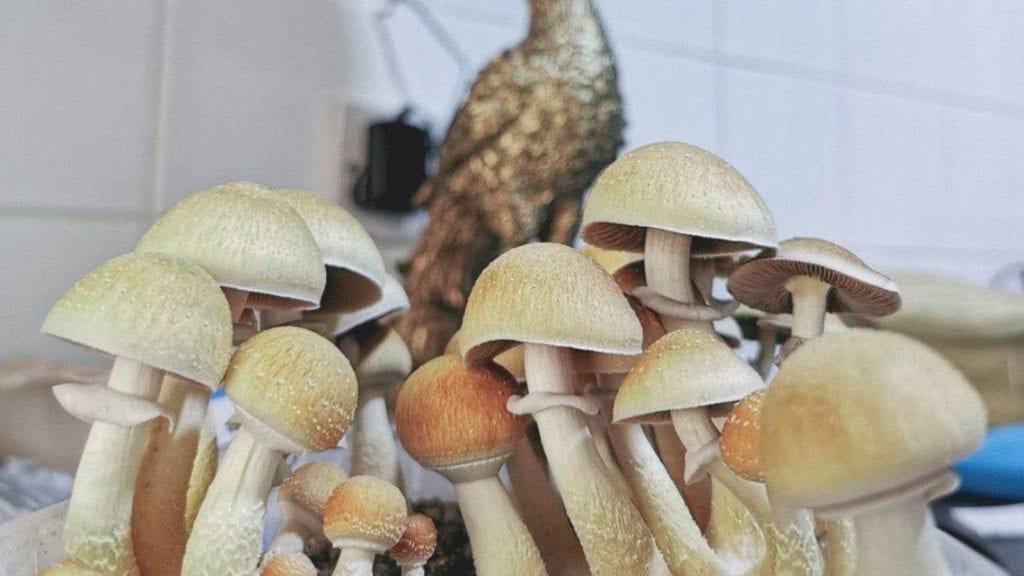
Dosing is recommended with caution for Amazonians unless you’re already heavily experienced with psilocybin mushrooms.
3. African Transkei Mushrooms — Psilocybe cubensis.
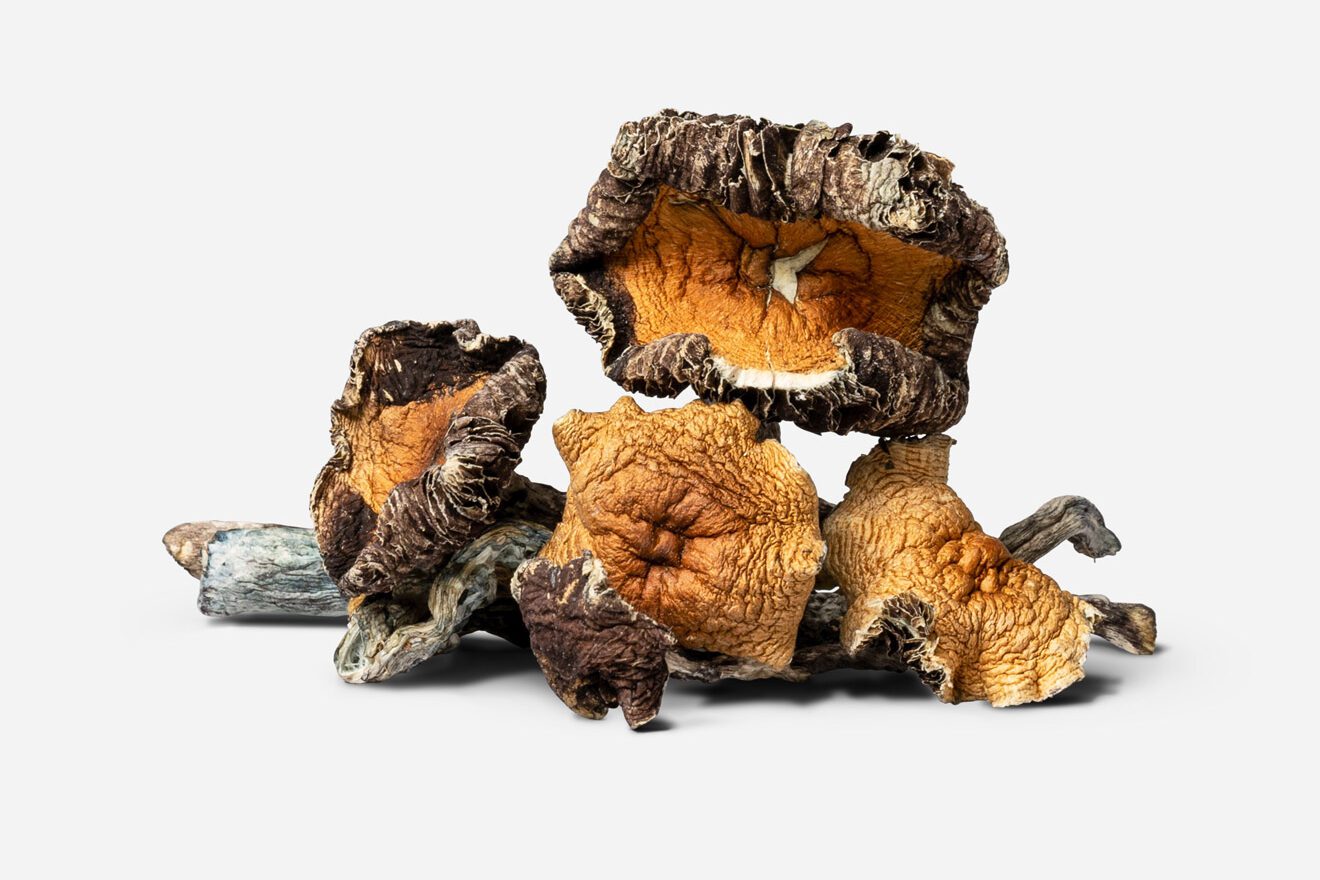
As their name suggests, the African Transkei magic mushroom strain hails from the African continent, South Africa to be specific. It’s the first magic mushroom strain to originate in Africa and circulate the world for cultivation.
When African Transeki are young, they make bright orange caps that progressively turn white as they mature, so you might notice slightly different colouring on dried African Transekis.

Less physical than other magic mushroom strains, African Transekis compensate with some of the strongest visuals. Naturally, the psychonauts who seek out African Transki mushrooms are those who love strong, psychedelic, visual effects.
Beginners should beware with their dosing of African Transekis because they can easily become “too much.”
4. Penis Envy Mushrooms — Psilocybe cubensis.

Penis Envy mushrooms can be identified by their large and bulbous stem, similar in shape to a human penis.
Penis Envy mushrooms are more challenging to cultivate than other mushrooms and less tolerant to contamination. This magic mushroom strain is often used for microdosing because of its high potency.
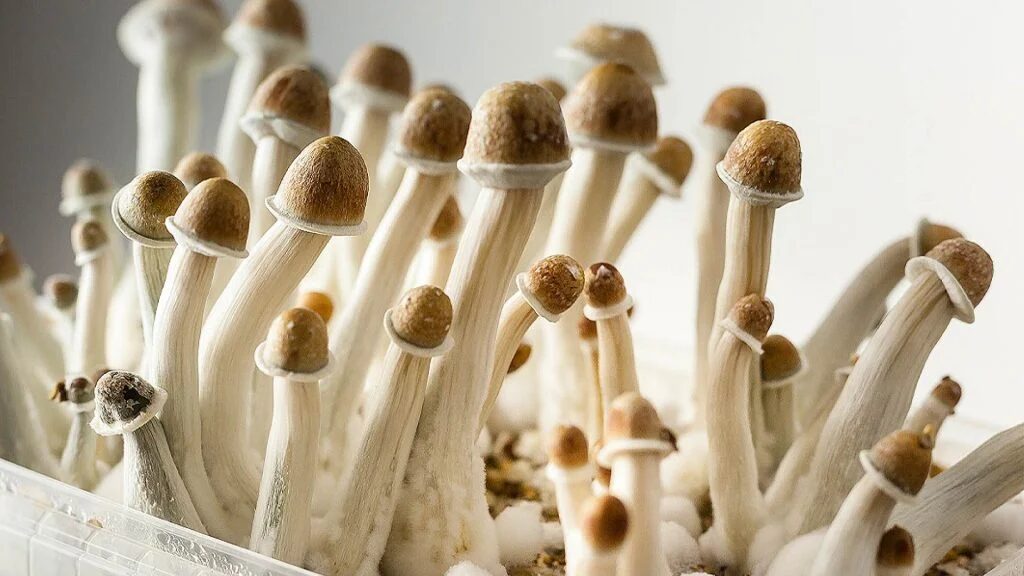
Penis Envy mushrooms are particularly potent. When consuming this magic mushroom strain, you should lower your dosage by 30% for a manageable trip.
The average dosages for the penis envy mushroom:
- Microdose: 0.05g to 0.2g
- Mini-dose: 0.2g- 0.5g
- Museum: 0.5g to 1.0g
- Moderate: 1.0g to 2.0g
- Megadose: 2.0g to 3.0g
Watch the video below to learn more about penis envy mushrooms.
5. B+ Mushrooms — Psilocybe cubensis.
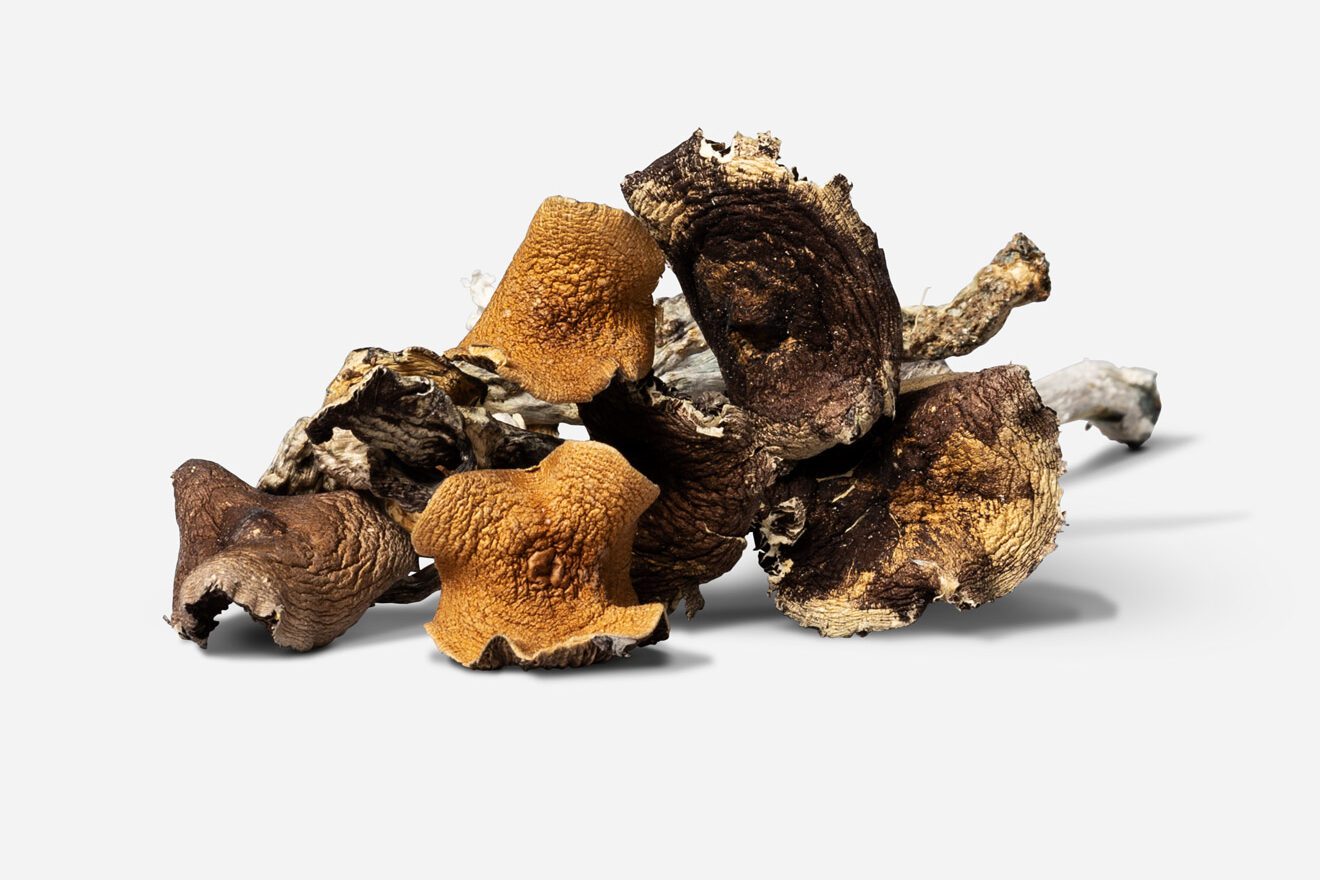
B+ psilocybin mushrooms are named after their positive effects and ability to grow in a wide range of conditions. They are known for their thick stems and large, meaty caps that are usually smooth and light brown with a dark center.
It is a potent strain that can provide users with intense visuals and a strong sense of euphoria. Many users also report feeling a sense of clarity and focus after taking this strain.
B+ mushrooms were allegedly created by Mr. G, a legendary mushroom cultivator who also developed other strains such as A+, Albino Treasure Coast, and Fuzzy Balls. Mr. G claimed that B+ was a hybrid between P. cubensis and P. azurescens, a more potent species of psilocybe. However, this claim has not been verified and most experts doubt that such a cross is possible.
B+ mushrooms are considered to have an average potency among P. cubensis strains. According to the Psilocybin Cup, a competition that tests the potency of different mushroom strains, the average psilocybin and psilocin content of B+ mushrooms was 0.59% and 0.11%, respectively. However, the potency can vary significantly from one type of magic mushroom strain to another, depending on the genetics, growing conditions, and harvesting time.
The effects of B+ mushrooms are similar to those of other P. cubensis strains, but they are generally more gentle and balanced. Users report experiencing euphoria, enhanced creativity, altered perception, introspection, spiritual insights, and mystical experiences. Some users also report mild visual hallucinations, such as seeing patterns, colors, or geometric shapes.
6. Cambodian Psilocybin Mushrooms — Psilocybe cubensis.
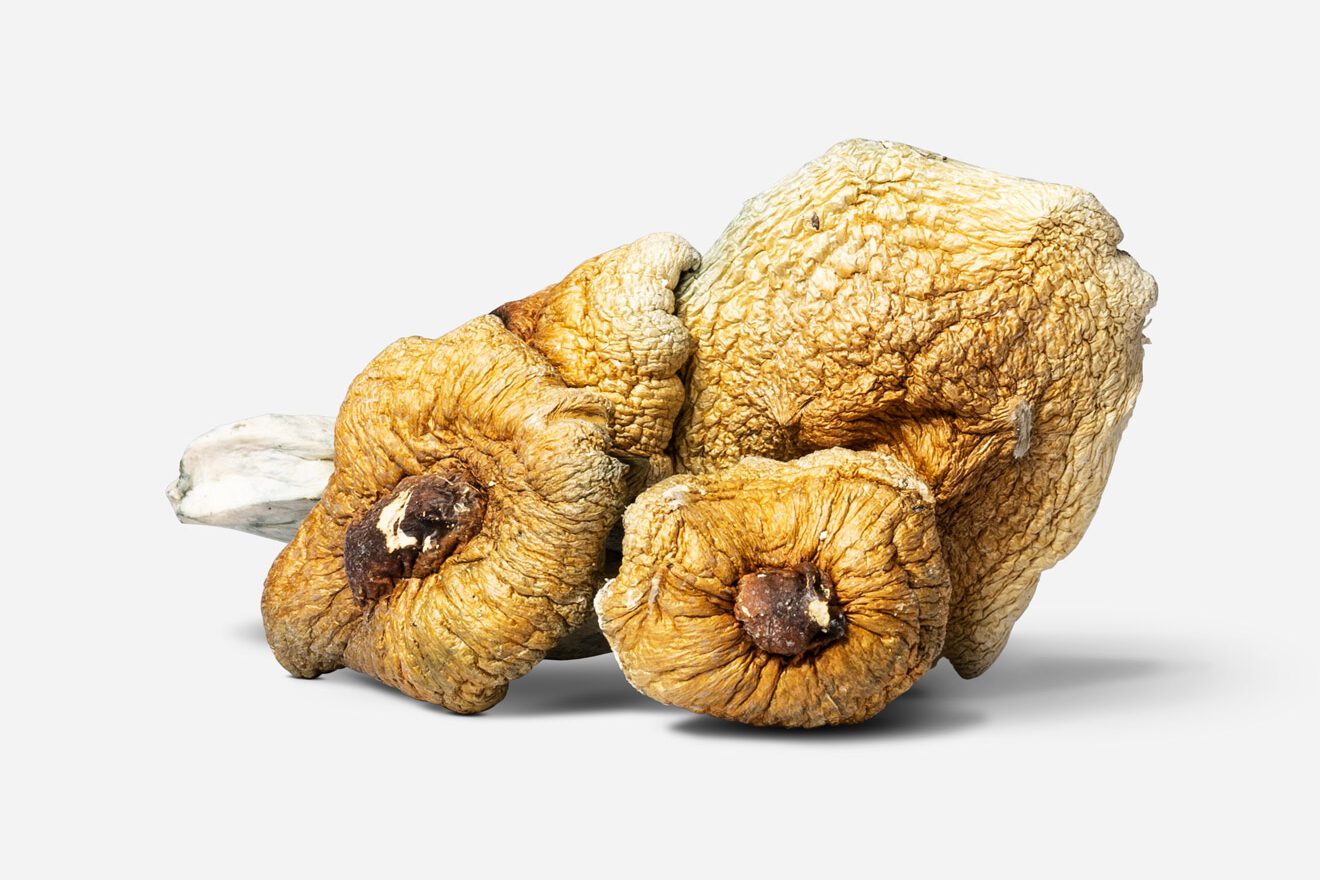
Cambodian mushrooms have brown caps and small bodies. They are named after their origin, Cambodia, where they were discovered near the Angkor Wat temple. They are easy to grow, resilient to contamination, and produce large and light-colored caps.
The effects of Cambodian psilocybin mushrooms are similar to other P. cubensis strains, but they are usually more mild and energetic. Users report feeling euphoric, creative, and inspired, with some visual distortions and spiritual insights.
They have also been said to have less visual high-potency trips but bring in more creativity.
Cambodian magic mushrooms are a great choice for beginners and experienced users alike, as they offer a rewarding and enjoyable psychedelic experience.
7. Blue Meanie Mushrooms — Panaeolus cyanescens.
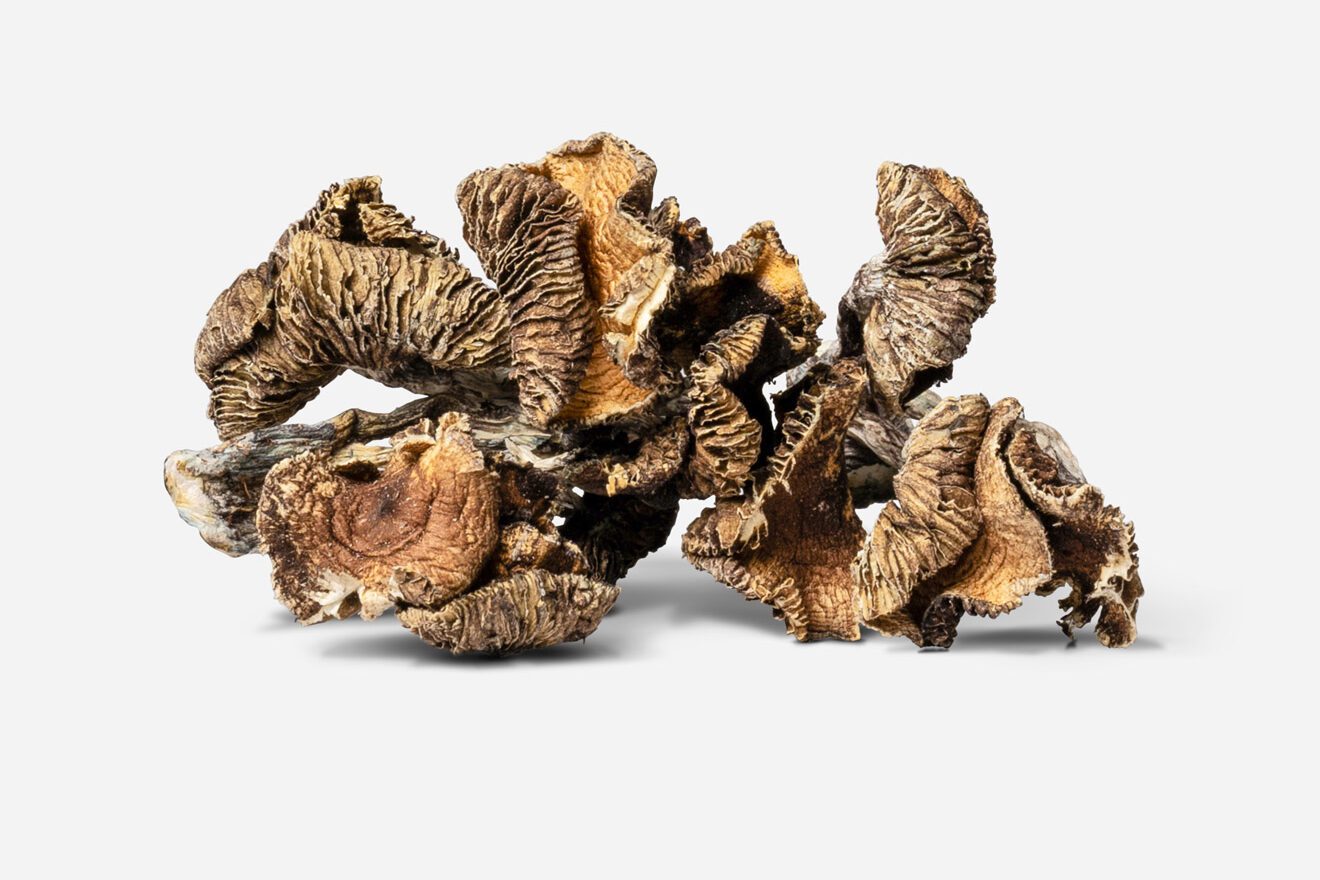
Unlike the preceding types of psychedelic mushrooms on this list, Blue Meanie mushrooms are from an altogether different species of magic mushrooms called Panaeolus Cyanescens.
They're particularly known for their unique appearance, like the eponymous blue coloration on their stems and caps. When damaged or bruised, Blue Meanies can turn a deep blue color. This is just the oxidation of the compound psilocin, but it's more pronounced in Blue Meanies than other types of Psilocybe cubensis due to their higher-than-average psilocybin and psilocin content.
The caps are usually broad and rounded, and range from a light to medium brown color with a sometimes blue or blue-green tint. Blue Meanie stems are also often thicker than the stems of most Psilocybe cubensis strains.
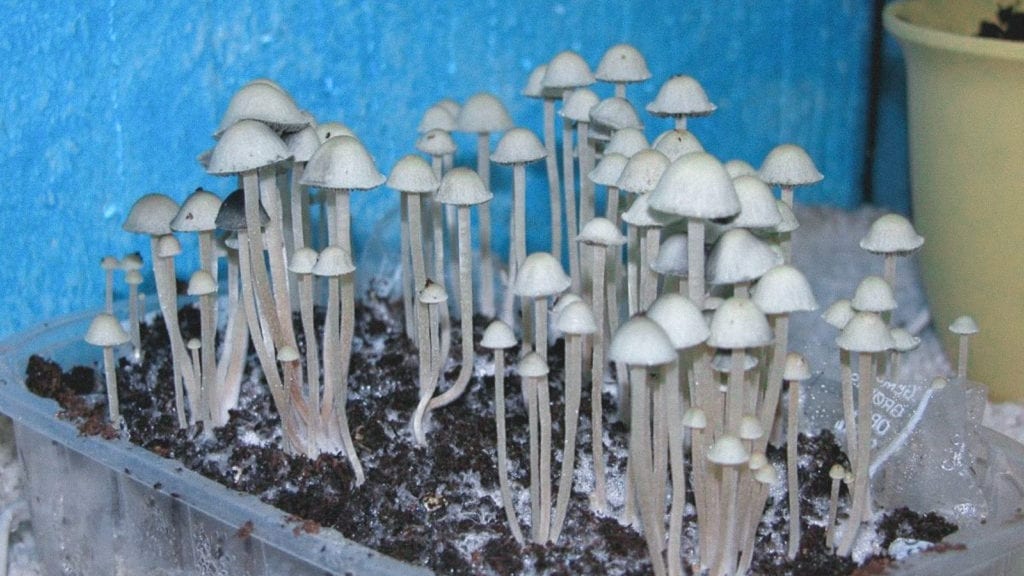
Blue Meanies get their name because they are super potent — so they’re not considered the most friendly bunch. They’re considered among the most potent magic mushroom strains in the world, with almost twice the psilocybin content of other common mushroom species.
Blue Meanies' psychedelic effects range from 4 - 8 hours, with intense auditory and visual hallucinations and a heavy body load. They're known for their intense and vivid sensory experiences, and users often report increased introspection, self-awareness, and profound insights and revelations about themselves and the world around them.
We don't recommend Blue Meanies for beginners. Instead, opt for a more gentle mushroom strain, like Golden Teachers.
8. Wavy Cap Mushrooms — Panaeolus cyanescens.

Wavy Caps are saprophytic mushrooms native to the West Coast of North America, particularly abundant in Oregon. These mushrooms are named for their large caramel-colored caps, which have a distinctive wavy shape. They feed on decomposing material.
These mushrooms thrive in cold weather and are well-suited for outdoor cultivation, but with the right temperature control, you can also grow them indoors. Gardens with wood chips are a particularly suitable environment for their growth.
In terms of potency, Wavy Caps are moderately strong, containing approximately 0.85% psilocybin.
When consumed, users report a range of experiences. At higher doses, some describe encounters akin to those of DMT, involving profound spiritual experiences. Others mention experiencing a body high, along with auditory and visual hallucinations, nausea, and euphoria.
9. Liberty Cap Mushrooms — Psilocybe semilanceata.
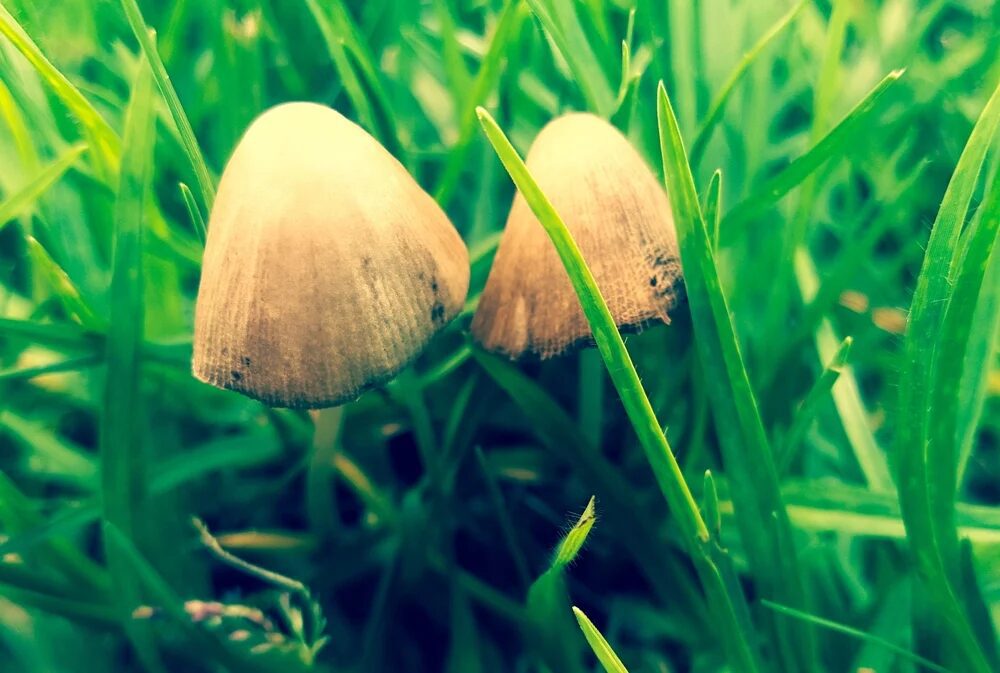
Liberty Caps, also known as Psilocybe semilanceata, is a well-known type of magic mushroom that can be easily found in the wild. They are commonly found in Europe but can also be spotted in North America, South Africa, Chile, Northern India, Australia, and New Zealand.
You'll typically find Liberty Caps in grassy areas like meadows and pastures from late summer to early winter. However, they aren’t associated with cow dung. They prefer damp soil and cooler temperatures, so you'll mostly encounter them in places with mild, wet climates. You can also grow these mushrooms both indoors and outdoors.
Liberty Caps have long, thin stems and distinct, bell-shaped caps, which is how they got their nickname.
By comparison, Liberty Caps look much more like Blue Meanies than they do Golden Teachers. But they have a noticeably yellowish, pointy cap that is pale everywhere except for the tip.
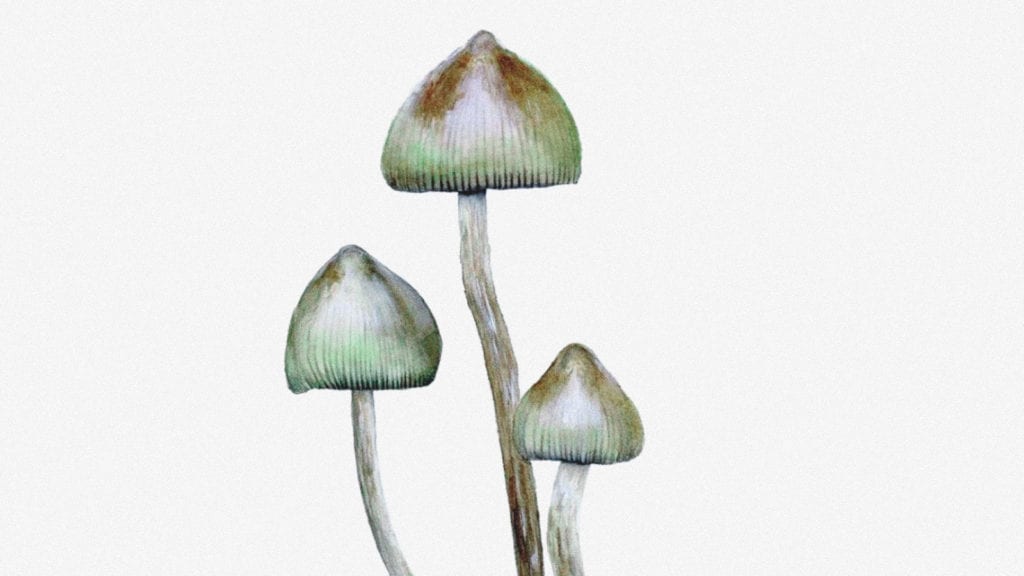
With approximately 0.98% psilocybin, 0.02% psilocin, and 0.36% baeocystin, Liberty Caps are highly potent, more so than Blue Meanies and Wavy Caps.
People who've tried Liberty Caps have reported experiencing a strong "head high" rather than a "body high." This can lead to vivid visual hallucinations.
Overall, people consider Liberty Caps to be pretty strong, but also friendly. According to some old research, Liberty Caps were considered among the strongest Psilocybes. However, that research took place in the 70s when fewer psilocybin mushroom species had been identified.
10. Banded Mottlegill Mushrooms — Panaeolus cinctulus.

The Panaeolus cinctulus mushroom strain has caps that can grow up to two inches in diameter. Initially, these caps are shaped like domes, but as they mature, they become flat. The color of the caps changes depending on whether the mushroom is moist or dry. When they are moist, the caps have a reddish-brown hue, and when they dry out, they turn creamy white.
Banded Mottlegill mushrooms are generally considered to be about half as potent as the typical Psilocybe cubensis variety. If you're considering microdosing and are used to dosing with Psilocybe cubensis, a good starting point would be at least the same amount as your preferred Psilocybe cubensis dose. If you're not feeling the effects after an hour or so, you can always take a little more and see how you go from there.
Most people who have tried Psilocybe cinctulus report vivid visual hallucinations. These can include seeing vibrant colors, perceiving people with larger-than-life eyes, or even experiencing a somewhat cartoon-like reality.
Alongside these visual effects, users often describe feelings of joy and happiness. Some have also mentioned a sensation of their surroundings moving in slow motion.
11. Flying Saucer Mushrooms — Psilocybe azurescens.
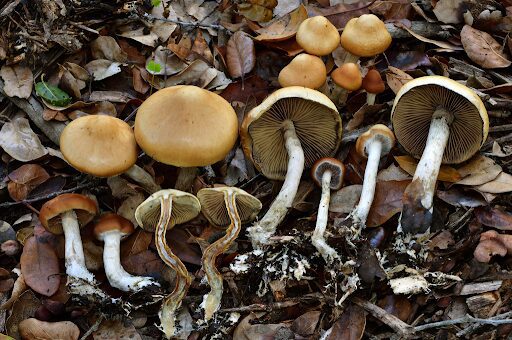
Known as Flying Saucer mushrooms due to their wide, UFO-shaped caps, Psilocybe azurescens is a species of magic mushroom local to Canada. Though they originated in Oregon, they’ve spread across the Pacific West since the 80s. This species of mushrooms is a particularly wood loving species, preferring to grow on tanbark, under trees, and typically around the forest (in contrast to many other species which grow under cow dung).
Mushroom expert Paul Stamets provides a vivid description of these mushrooms, noting that they have "caramel-colored" caps and stems with a distinctive "twisted, cartilaginous, silky white fibrous tissue."
Psilocybe azurescens are known for their potency, having higher psilocybin (1.78%) and psilocin levels than other Psilocybes.
Interestingly, Psilocybe azurescens is able to produce a phenomenon called “wood lovers paralysis”. This is a transient form of muscle paralysis that only happens to some people, some of the time with wood-loving mushroom species. It most commonly occurs with Psilocybe azurescens and Psilocybe cyanescens (not to be confused with Panaeolus cyanescens).

When consuming these mushrooms at moderate to high doses, one can expect intense visual experiences, a significant physical sensation, and profound alterations in their perception of reality.
This strain is really only recommended for experienced mushroom users, if ever you come across it. The paralysis that is sometimes associated with Psilocybe azurescens is transient, and shouldn’t cause any concern.
12. Teonanacatl/Mexicana Mushroom — Psilocybe mexicana.
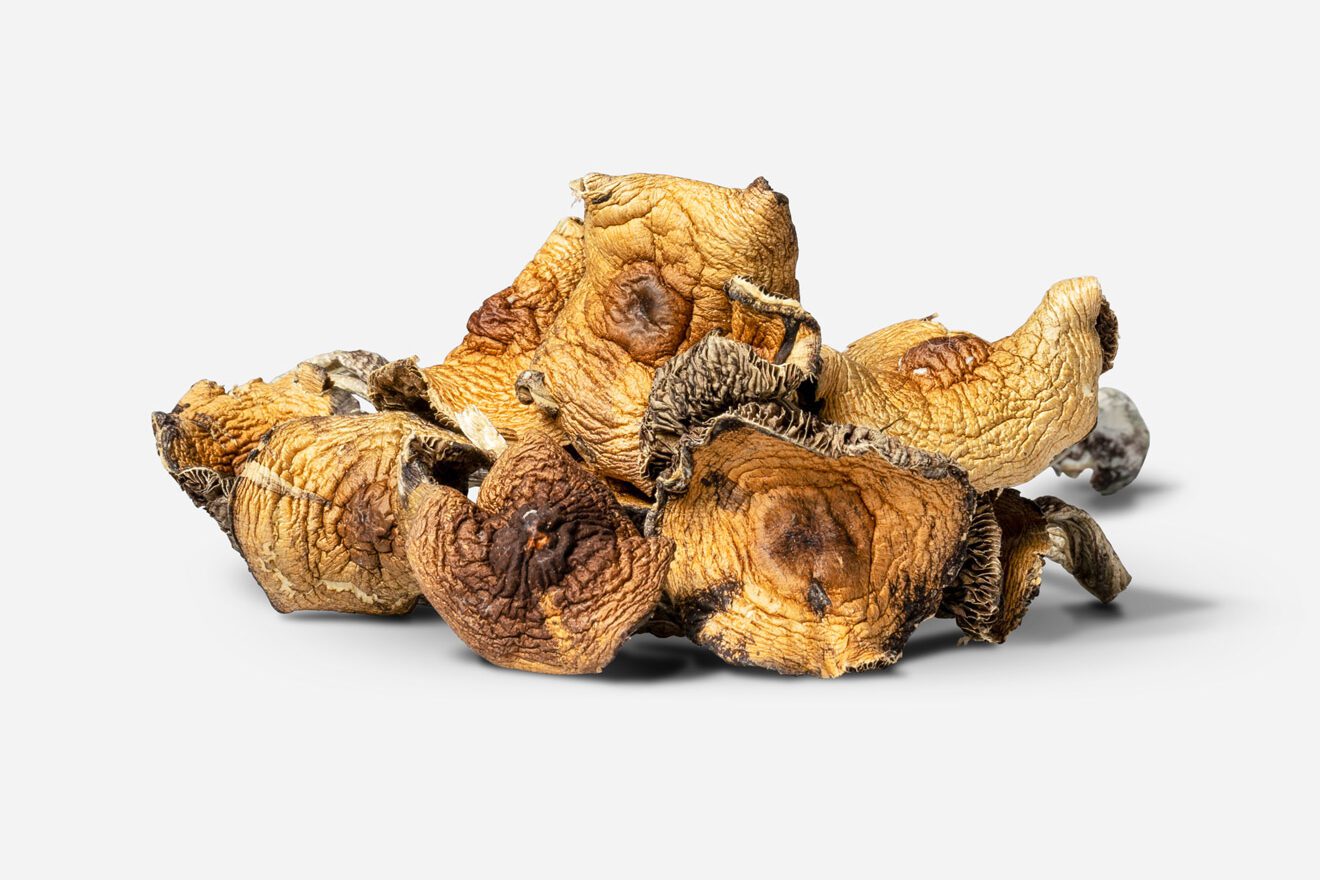
As its name suggests, the mexicana mushroom species within the Psilocybe genus is native to Mexico. Its Aztec name (teonanacatl) literally translates to God-mushroom, or flesh of the Gods.
It was traditionally used by the Aztec people for entheogenic ceremonies and rituals. It also has a special place in clinical history as the first psilocybin mushroom species used to isolate psilocybin and psilocin.
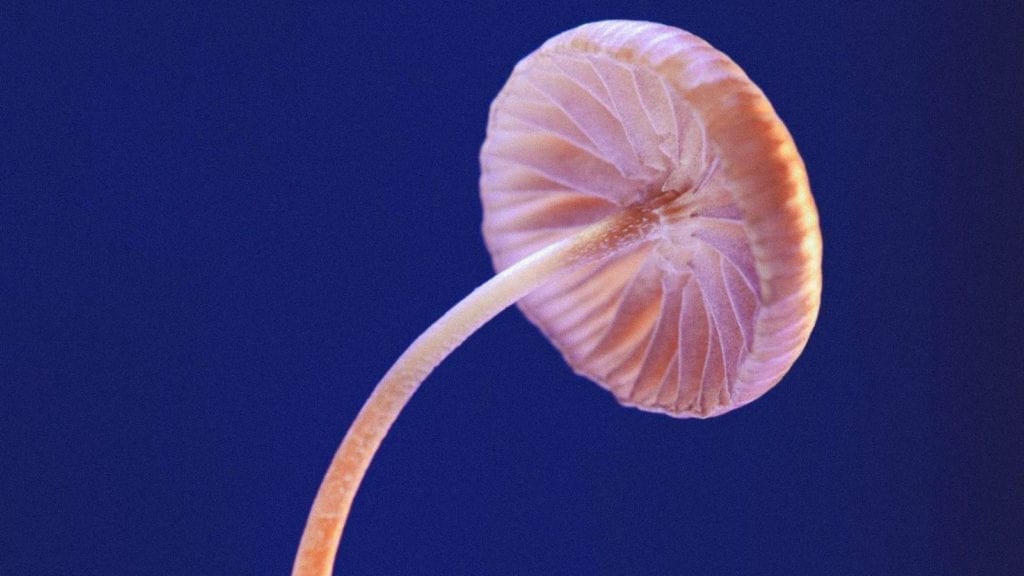
In terms of appearance, they look a lot like Liberty Caps and Blue Meanies.
The journey is strongly enlightening, much like Golden Teachers, but they also bring on a very visual experience. It’s recommended that beginners start with a lower dose of Mexicana.
13. Psychedelic Ovoid Mushroom — Psilocybe ovoideocystidiata.

In 2007, mycologists Richard Gaines and Gaston Guzman made a significant discovery by identifying the Psilocybe ovoideocystidiata mushroom. They conducted their research using samples collected back in 2003 from wood chips located alongside a trail within Evansburg State Park, Pennsylvania.
Much like other species of psilocybe mushrooms that thrive in woody environments, Psilocybe ovoideocystidiata is a saprobic organism. This means it sustains itself by extracting nutrients from decomposing organic matter.
The caps of these magic mushroom strains typically exhibit a dome-like shape, sometimes featuring a small bump in the center. Their diameter can reach up to 1¾ inches. When fresh, the caps sport an orange-brown color, which lightens to a pale yellow when dried. The stem's color may vary, appearing as pale off-white with streaks of yellow, brown, or even hints of blue.
In terms of potency, Psilocybe ovoideocystidiata contains an average of 0.45% psilocybin, 0.13% psilocin, and 0.2% baeocystin, placing it in the category of moderately potent psilocybin mushrooms.
The psychedelic effects associated with this mushroom include changes in perception, distortions in one's sense of time, and feelings of joy. If you have any specific questions or need further information, feel free to ask!
14. Blue-foot Mushroom — Psilocybe caerulipes.
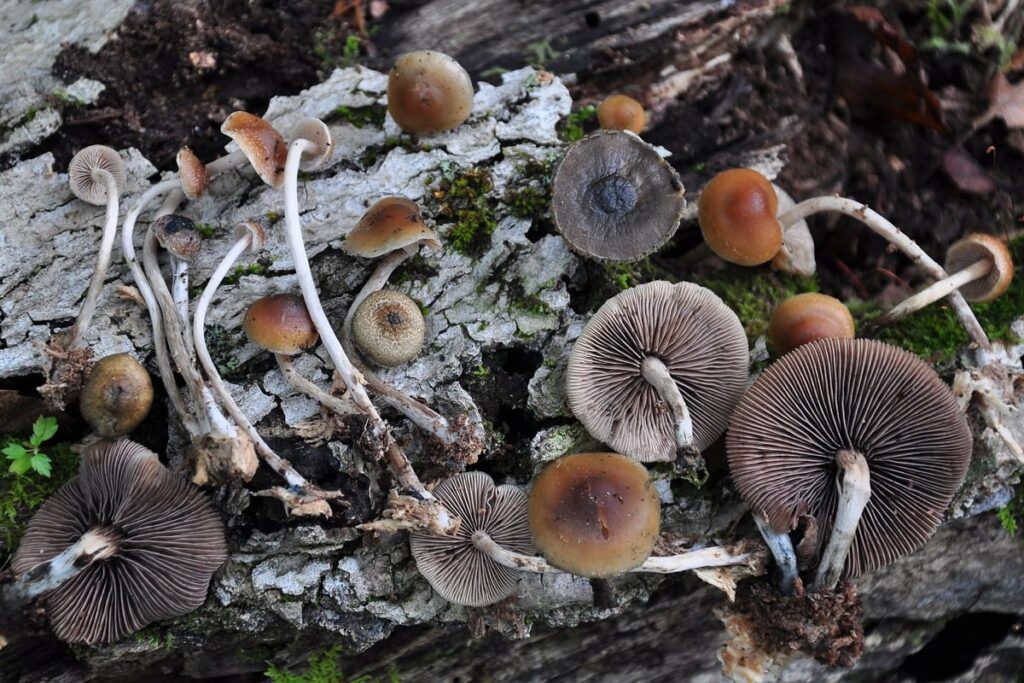
Psilocybe caerulipes is commonly known as the "Blue-foot Mushroom." These mushrooms are characterized by small to medium-sized conical to bell-shaped caps, with a diameter ranging from 1 to 4 centimeters. The cap color can be quite variable, often appearing brownish or yellowish-brown. A distinctive feature is the bluish-green hue found on the base of the stem, which gives the mushroom its name.
In 2022 the National Library of Medicine conducted a study on psilocybin mushrooms and discovered that Psilocybe caerulipes had between 0.2% and 0.6% of psilocybin and 0.05% to 0.3% percent of psilocin.
Users have reported having a positive experience due to feeling connected to other people, nature, and the universe. Other senses and feelings also become stronger.
15. Psilocybe allenii.
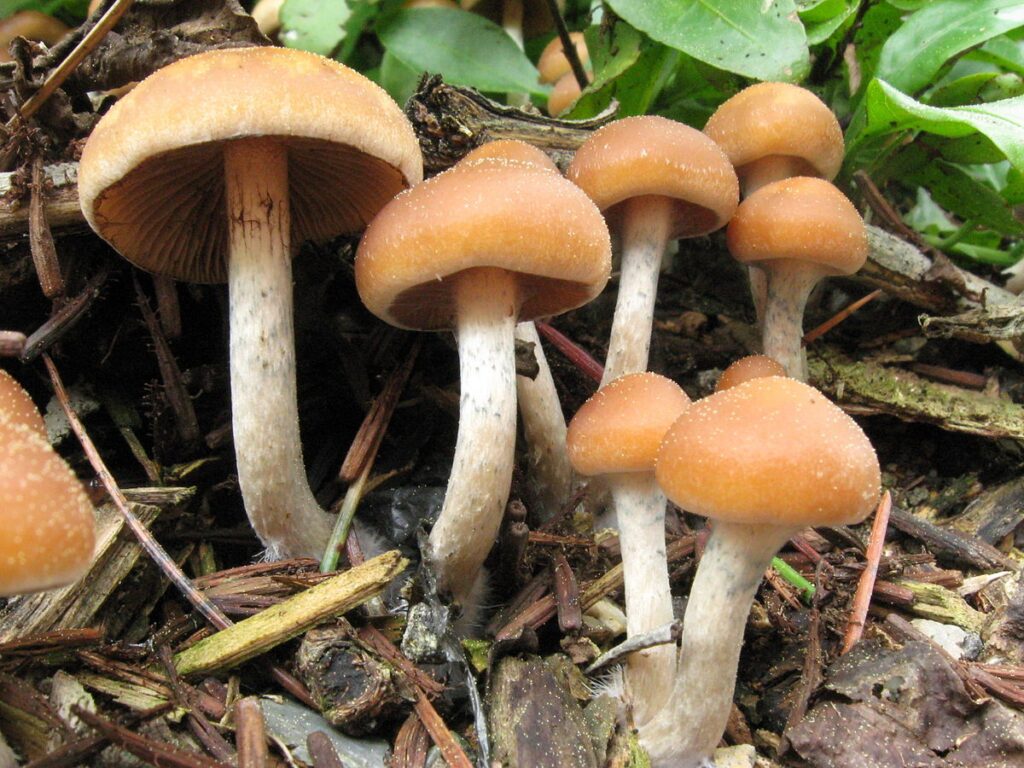
Meet Psilocybe allenii, the mushroom that evaded even skilled mycologists for decades. The magic mushroom strains from this species are known for their hallucinogenic effects and have been used for centuries by Native American cultures for spiritual and medicinal purposes. Psilocybe allenii can be seen along the western coast of the United States, from Washington to San Francisco and often appear in large groups. We still don’t know where this species originated.
The caps of Psilocybe allenii have a caramel-brown color when wet that shifts to a yellowish-straw color as they dry out.
Psilocybe allenii may contain up to 1.84 percent of psilocybin, which is highly potent, and anywhere from .04 to 1.81 percent of psilocin, depending on their environment.
Depending on how much you can tolerate, you will experience mild symptoms, including brighter colors, hallucinations outside of your direct vision, and short-term visual changes. The walls, ceiling, and artwork might appear to glimmer or shake. Also, your pupils can dilate, and your hands will become cold and clammy.
16. Big Laughing Gym — Gymnopilus luteus.
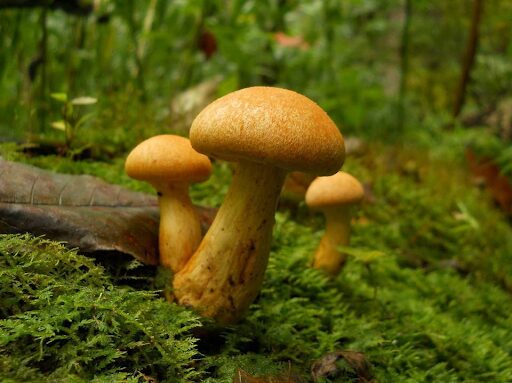
Gymnopilus luteus, also known as the Big Laughing Gym, is a popular edible mushroom that many people enjoy. Found in North America and other parts of the world, it’s a giant, orange-brown mushroom with a distinct peppery smell. It can be found in wooded areas, fields, and urban environments.
It is said that Gymnopilus luteus is a less potent hallucinogen than Psilocybe cubensis, but some records find it more potent. As is always the case with psilocybin, the mushroom’s potency varies, as does the user’s sensitivity.
Psilocin and psilocybin levels for this particular mushroom are higher than in other species, typically ranging from 0.1% to 0.5% of the total tryptamines when the mushrooms are dried.
Some have Gymnopilus luteus to be euphoric and have a soothing, sedative quality. Colors were also said to look more vibrant and enhanced compared to being consumed.
17. Philosopher's Stones Mushrooms — Psilocybe tampanensis.
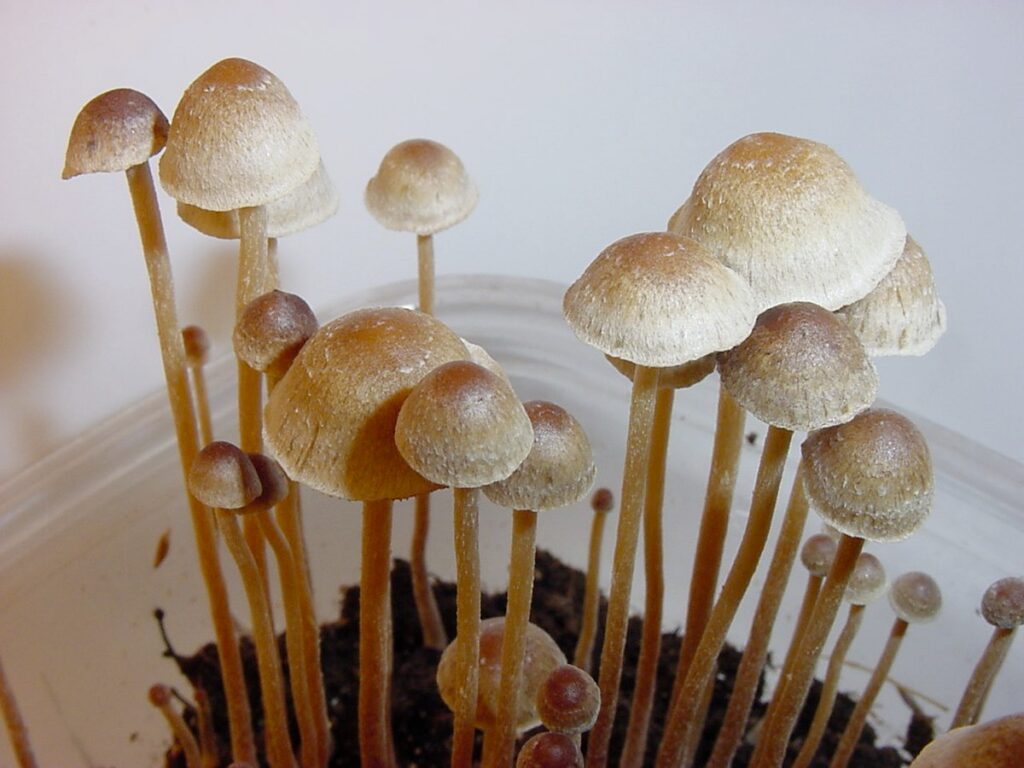
Psilocybe tampanensis is a rare type of mushroom typically found in subtropical environments along the Gulf Coast and in Mexico, mainly in Florida. It has a plain, brown appearance and is relatively small. Mycologists are the most interested in the sclerotia or truffles it produces.
These truffle-like sclerotia have psychoactive properties and are often called “philosopher’s stones,” due to their ability to induce spiritual and intuitive feelings.
With 0.68% psilocybin and 0.32% psilocin content, Psilocybe tampanensis is deemed to have a medium potency level compared to other magic mushroom strains.
However, users describe effects similar to DMT journeys in high doses, including mystical experiences and meeting entities
18. Natal Super Strength Mushrooms — Psilocybe natalensis.
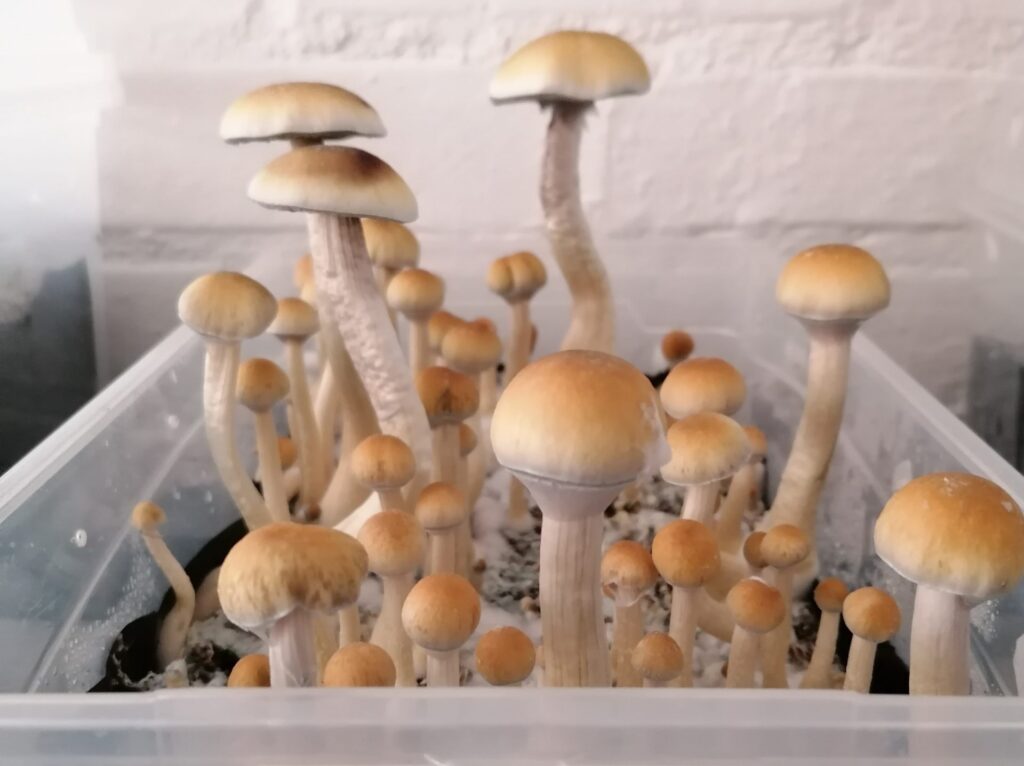
Psilocybe natalensis is a unique species of magic mushroom that grows in the Natal region of South Africa. Also known as “Natal Super Strength,” these mushrooms contain high amounts of the psychoactive compounds psilocybin, psilocin, and baeocystin.
Closely related to Psilocybe cubensis, Psilocybe natalensis is usually much more potent. Some reports suggest that Psilocybe natalensis is twice as potent and more resilient to mold than Psilocybe cubensis. Because of its high resistance to mold, it’s less likely to be corrupted when growing, making it simpler to manage.
Due to the lack of research and evidence, the specifics of how this particular mushroom strain from South Africa was used on the continent have yet to be determined. However, researchers found murals in Tassili caves in southern Algeria, believed to be the oldest evidence of psychotropic mushrooms.
The strength of all psilocybin mushrooms varies greatly, but some estimates suggest that, on average, the Natal Super Strength magic mushroom strains are 1.5 to 2 times stronger than P. cubensis.
Based on personal experiences, Psilocybe natalensis is said to have fewer physical side effects and a smoother taste than Psilocybe cubensis. Some people have also found it more pleasant and uplifting, providing better visual effects than Psilocybe cubensis.
19. Magic Blue Gym Mushrooms — Gymnopilus aeruginosus.
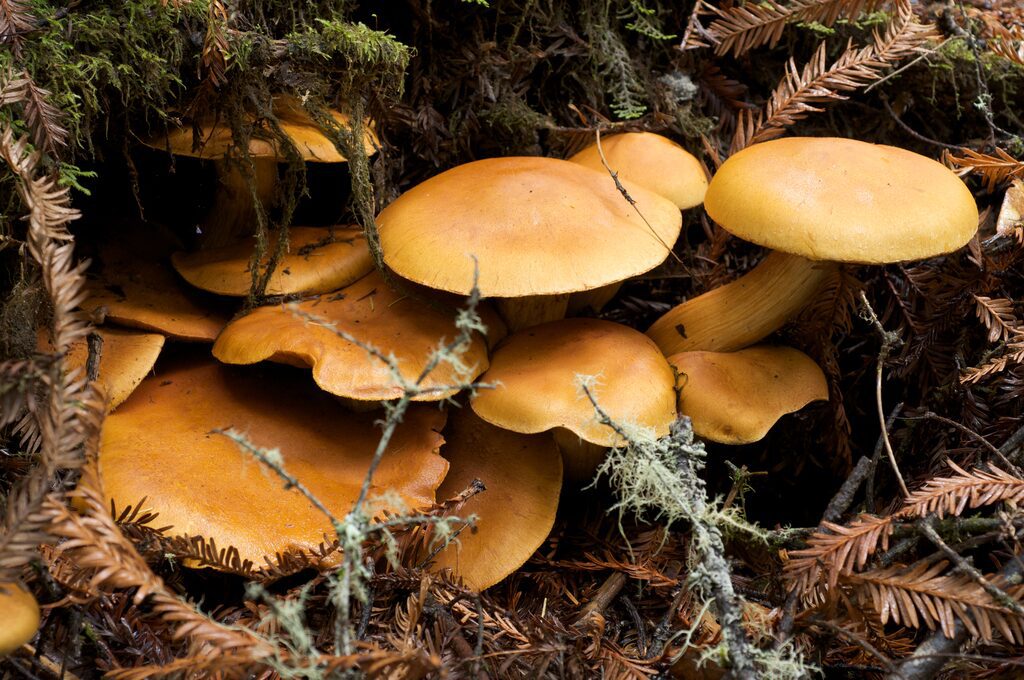
Gymnopilus aeruginosus, also known as the “magic blue gym,” is a magic mushroom strain that can be found growing in clusters on dead wood and wood chip mulch. It is very common in the Pacific Northwest and has a bitter taste and a rusty orange spore print.
While there is little information on the specific levels of psilocybin in Gymnopilus aeruginosus, the species does contain psilocybin, as do other members of the genus including the species Gymnopilus luteus, Gymnopilus viridans, and Gymnopilus spectabilis.
People have reported feeling a sense of euphoria and a buzzing sensation throughout their bodies. Others have described feeling completely relaxed and sedated. Many have also reported seeing vivid colors and other intense visuals.
20. Fly Agaric Mushrooms — Amanita muscaria.

Deep in the temporal and northern regions of the northern hemisphere, the infamous toadstool known as Amanita muscaria grows wild. It was accidentally introduced to the Southern Hemisphere and now grows almost anywhere the conditions will allow it. It’s the characteristic Christmas mushroom with a big red cap, covered in white spots.
Amanita muscaria is actually toxic if consumed fresh, out of the ground.
It’s rumoured that drinking the pee of reindeer that consume the Amanita is safe, but there are also other safe, less revolting ways it can be prepared. For example, the toxic compounds of Amanita muscaria mushrooms are water soluble, so boiling them in a lot of water for an extended period helps to leech them out.
Toxicity is quite common with Amanitas, so they’re very rarely (if ever) available for commercial sale.
Improper preparation can be fatal and lead to death, so they’re left out of commercial circulation altogether.
We also don’t recommend walking down the road of Amanita muscaria mushrooms unless you’re doing it with a guide or mycologist who is extremely experienced with using this species of magic mushroom.
Amanita Muscaria, Santa, and the Magic Mushroom Christmas Theory:
We already know that Christmas has its roots in folklore and mythology. But have you heard that psychedelic mushrooms may have something to do with it? True or not, many theories are circulating out there linking the red and white mushroom Amanita muscaria (a.k.a. the Fly Agaric) to the origins of Santa Claus and his flying reindeer. These are some of the theories, folklore, and legends that have been proposed regarding this association:
- Christmas Trees: The Fly Agaric mushroom grows under pine and birch trees, which are everybody's go-to Christmas trees. The mushroom has a symbiotic relationship with the tree roots, and its colors may have inspired the decorations of the tree and the gifts under it.
- Siberian Shamanism: The Fly Agaric has been used by the indigenous people of Siberia, such as the Sami, in their shamanic rituals—especially during the winter solstice. These shamans would dress in red and white, similar to the mushroom's colors, and distribute the mushroom as gifts during winter solstice celebrations. This has led to speculation that the mushroom's use might have influenced the modern image of Santa Claus or Father Christmas, who also wears red and white attire.
- Reindeer Snacks: It's well-known that the Fly Agaric is a favourite food of reindeer, who seek it for its intoxicating effects! The reindeer would then act strangely, running and jumping around, which may have inspired the legend of flying reindeer—talk about getting high. The shamans would also drink the urine of the reindeer—which filters out the Fly Agaric's toxic constituents—and experience a high similar to LSD. It's through this trance that they would communicate with spirits and ancestors.
- Stocking Stuffers: Because the Fly Agaric mushroom retains a lot of water, people would hang stockings full of the mushrooms over the fireplace to dry them. Like Santa, the shamans would then enter the houses through the smoke hole or chimney carrying a sack full of mushrooms, and place them under the tree or inside the stockings as presents.
Now, these are just stories, not facts, and there is no concrete evidence or consensus on this topic. But it is fun to imagine how psychedelic mushrooms could have lent to the creation of some of our favourite holidays and traditions!
There are literally thousands more.
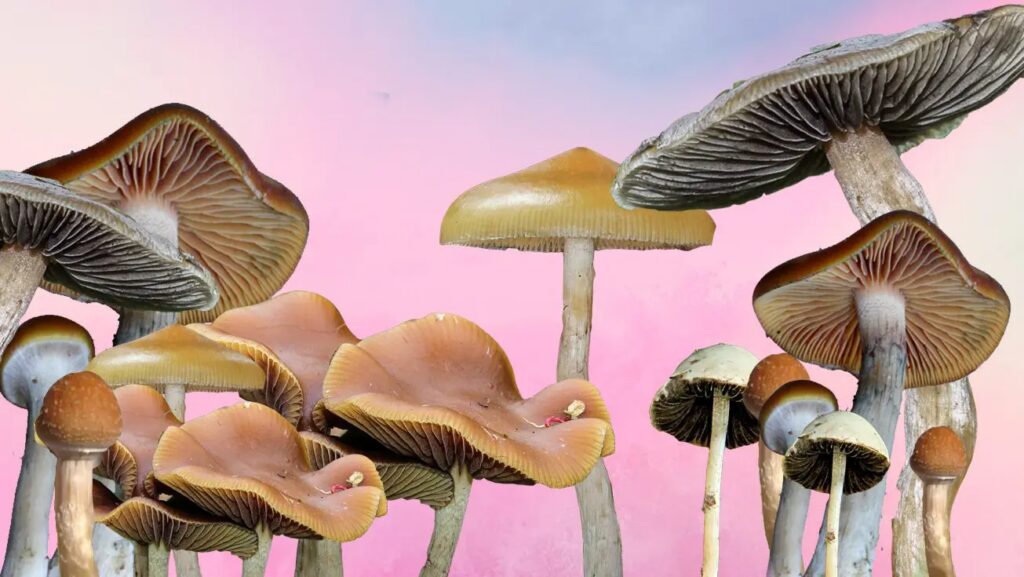
This is not an exhaustive list of magic mushroom strains and species around the world. In fact, there are thousands more. One of the ongoing issues in mycology is the inability to identify varieties and strains. We are only aware of a small number of fungi species in the grand scheme of things.
Each part of the world typically has its own magic mushroom strains. Thanks to cultivation, we now have access to some of the world’s native strains, like those listed in this article. So this article gives you a small peek into the colourful world of fun-guys.
What are your favourite magic mushroom strain? Let us know in the comments.
Psilocybin mushroom FAQs.
-
How do psilocybin mushrooms work in the brain?
Psilocybin mushrooms work by activating serotonin receptors in the brain, especially in the prefrontal cortex, which is involved in mood, cognition, and perception. Psilocybin also affects other brain regions, such as the amygdala, which is involved in emotional processing, and the hippocampus, which is involved in memory formation. Psilocybin can alter the way people perceive themselves and their environment, as well as their sense of time and space.
-
What are the effects of psilocybin mushrooms?
The effects of psilocybin mushrooms vary depending on the dose, the individual, the setting, and the expectations of the user. Some common effects include euphoria, altered sensory perception, enhanced creativity, introspection, spiritual insight, empathy, and mystical experiences. Some possible negative effects include anxiety, paranoia, confusion, nausea, and panic.
-
How long do psilocybin mushrooms last?
The duration of psilocybin mushrooms depends on the dose and your metabolism. Typically, the effects begin within 20 to 40 minutes of ingestion and last for about 4 to 6 hours. However, some residual effects may linger for up to 24 hours after the trip.
-
Are psilocybin mushrooms addictive?
Psilocybin mushrooms are not considered to be addictive or habit-forming. They do not produce physical dependence or withdrawal symptoms. However, some users may develop psychological dependence or tolerance to psilocybin mushrooms if they use them frequently or in high doses.
-
What are the benefits of psilocybin mushrooms?
Psilocybin mushrooms have been used for thousands of years for spiritual and medical purposes. They have been shown to have therapeutic potential for treating various conditions such as depression, anxiety, addiction, PTSD, OCD, and end-of-life distress. Psilocybin mushrooms can also enhance well-being, creativity, and personal growth for healthy individuals.
-
What are the risks of psilocybin mushrooms?
Psilocybin mushrooms are among the safest drugs and are generally safe when used in a controlled setting with proper guidance—such as with a psychedelic therapist—and preparation. However, they can also pose some risks if used irresponsibly or without adequate support. Some of these risks include having a bad trip, experiencing psychological distress or trauma, triggering or worsening underlying mental disorders, impairing judgment or coordination, mixing with other substances or medications, or consuming contaminated or misidentified mushrooms.
-
Can I take psilocybin mushrooms for depression?
Psilocybin mushrooms may work for depression by restoring the balance of serotonin in the brain, namely serotonin 5-HT2A, which is a chemical messenger that plays an important part in mood regulation. Low or imbalanced levels of serotonin can lead to depression and anxiety. By stimulating serotonin 5-HT2A, psilocybin triggers increased BDNF (brain-derived neurotrophic factor) and glutamate, low levels of which are associated with depression.
Psilocybin therapy can also induce mystical experiences, enhanced creativity, introspection, spiritual insight, empathy, and well-being for some people. A phase 2 clinical trial from 2021 suggests that psilocybin may be as effective as escitalopram (Lexapro), a commonly prescribed SSRI, for managing depression. A small 2020 clinical trial also suggests that psilocybin administered in conjunction with psychotherapy may be effective in treating people with major depressive disorder (MDD).
-
What is psilocybin therapy?
Psilocybin therapy is a type of psychiatric practice that involves ingesting a psychedelic substance that is native to a specific type of mushroom in a psychotherapeutic setting. Psilocybin therapy involves a patient taking psilocybin while in the care of a therapist. The patient goes on a psychedelic journey in this controlled, safe environment, and the therapist facilitates their experience. The session lasts six to eight hours, which is the full duration of the medicine's effects. The goal of psilocybin therapy is to impact emotional obstacles and long-term problems expediently by utilizing the psychedelic journey, rather than spending months or years in talk therapy slowly working through them. Find and connect with a psilocybin therapist in Canada today through our Trusted Psychedelic Therapists portal.